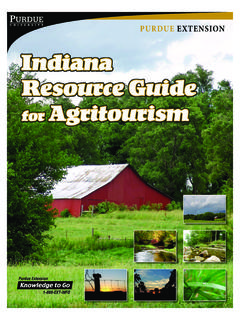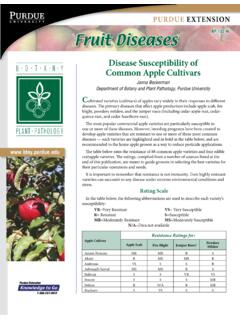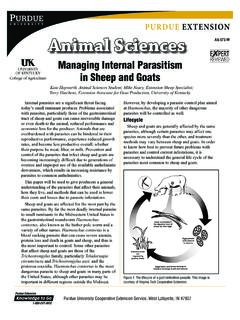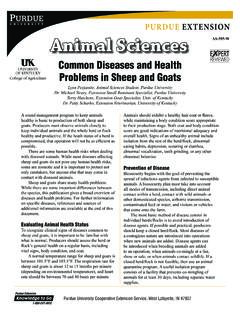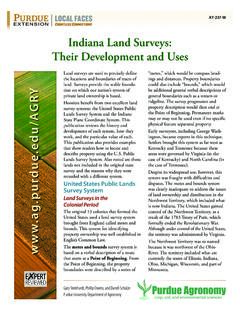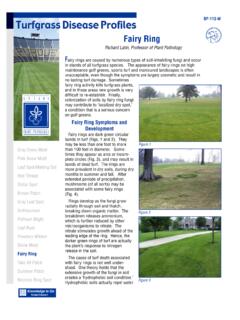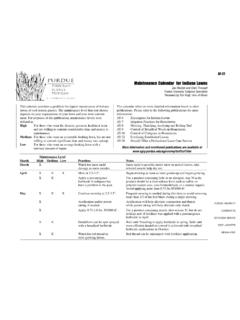Transcription of Managing Wheat by Growth Stage - Home - Purdue Extension
1 Managing Wheat by Growth Stage Purdue Extension Purdue Extension ID-422. Managing Wheat by Growth Stage Kiersten Wise, Bill Johnson.. Purdue Botany and Plant Pathology Chuck Mansfield.. Purdue Agronomy Christian Krupke.. Purdue Entomology Management decisions in Wheat produc- Growth Staging Wheat tion are Growth - Stage dependent. Applying The Feekes scale is a numerical scale. It fertilizers, herbicides, and fungicides are begins at Feekes (which describes most effective and profitable when applied emergence) and ends in (which at specific times during Wheat develop- describes a mature plant that is ready for ment. If certain chemicals are applied at harvest). the wrong Growth Stage , they may be ineffective or even damage the crop. Traditionally, the Feekes scale only uses Understanding how to correctly identify decimal subdivisions to describe develop- Wheat Growth stages can help producers ment stages during head emergence to make timely and profitable management maturity (Feekes through ).
2 Decisions. However, some publications and sales documents may use decimal numbers with This publication describes provides the Feekes scale to describe the number of descriptions and images of key Wheat tillers in the early stages of Wheat develop- Growth stages to help readers identify ment. them. This publication also includes brief descriptions of management consider- Feekes 1: Emergence ations at individual Wheat Growth stages. Feekes Growth Stage 1 is an important time to check Wheat plants for uniform Growth Stage Scales emergence and to determine if it is neces- There are several scales that describe the sary to apply herbicides to control winter Growth and development of cereal crops, annual grasses or other weeds such as including Wheat . Commonly used scales chickweed, deadnettle, henbit, and garlic.
3 Include the Feekes scale, the Haun scale, the BBCH scale, and the Zadoks scale. Feekes 2-3: Tillering Each scale differs in the level of detail it Feekes Growth Stage 2 describes plants that uses to describe the stages of crop Growth . are beginning to tiller, meaning the plant is producing axillary or side shoots. The Zadoks and BBCH scales are com- Traditionally, there is no intermediate monly used in Europe, while the Feekes distinction between beginning tillering scale is more widely used in the United (Feekes 2) and Feekes Growth Stage 3, States. In this publication we will use the which describes a plant that has completed Feekes scale. forming tillers (Figure 1). Photos by Kiersten Wise, Greg Shaner, Chuck Mansfield 1. Managing Wheat by Growth Stage Purdue Extension Figure 1. Wheat between Feekes Growth stages 2 and 3 this plant has not Figure 2.
4 Individual Wheat plant (above) and Wheat in the field (below) at Feekes completed tiller formation. Growth Stage 5. Note the plant's dark green color. The greening up phase is a time for making critical management decisions Adaptations of the Feekes scale can use a decimal after the Growth Stage number to describe the number of tillers observed. For example, a designation of Feekes indicates the plant has three tillers in addition to the main stem at Feekes If an individual wants to designate an intermediate Growth Stage between Feekes and Feekes , he or she must dig up plants and examine them carefully to determine number of tillers. Wheat development depends on weather conditions and planting date. Because of this, the amount of time it takes for Wheat to develop from Feekes 2 to Feekes 3. will vary.
5 Tillering may begin in the fall and not be complete until the following spring. If favorable weather conditions exist, early-planted Wheat may complete tiller formation before Wheat enters winter dormancy. Feekes 4-5: Green Up After tillers have formed, Wheat plants enter the green- Feekes Growth Stage 2-3 is when early nitrogen applica- ing up phase and begin erect Growth . This Stage is tions should be applied to enhance tillering in thin known as Feekes 4, and it is closely followed by Feekes 5. stands. Fall nitrogen application of 20-30 lb/acre is (Figure 2). sufficient for developing fall tillers. Spring tillering in thin stands can be encouraged by applying 30-50 lb/ Although these stages are difficult to distinguish from acre at dormancy break with the balance of spring each other in the field, they are important and distinct topdress nitrogen applied at Feekes 5.
6 Stages in the plants' development. Feekes 5 will not occur prior to vernalization (chilling), which occurs 2. Managing Wheat by Growth Stage Purdue Extension during the winter. After vernalization, Wheat plants begin to differentiate. At this point, Wheat head size (the number of spikelets per spike) is determined. Any additional tillers that form after Feekes 5 will not contribute to yield. Feekes Growth Stage 4-5 is an optimal time to make Developing spring topdress nitrogen applications and to apply head post-emergence herbicides for weed control. Check your state's weed control guide for current recommendations on herbicide products, timings, and rates in Indiana, see the Weed Control Guide for Ohio and Indiana ( Purdue Extension publication WS-16-W), available from the Purdue Extension Education Store, Feekes Growth Stage 4-5 also is an important time to scout for soilborne virus diseases and early-season foliar diseases such as powdery mildew and leaf blotch.
7 Feekes 6: Jointing Figure 4. At Feekes 6, the developing head is visible inside the stem. Feekes Growth Stage 6 is commonly referred to as Feekes Growth Stage 6 is the cutoff for applying certain jointing. At Feekes 6, the first node will be visible at the herbicides such as 2, 4-D and dicamba. Feekes 6 also is a base of the shoot (Figure 3). good time to cut-off nitrogen applications to prevent injury. Feekes 7-8: Two Nodes and Flag Leaf Feekes 7 is reached when two nodes are visible above the soil line. Purdue Extension Specialist Greg Shaner examined weather data to determine the approximate First node time needed for Wheat to develop in Indiana. His data indicate that it takes approximately one week for Wheat to develop from Feekes 6 to Feekes 7. Approximately five to 10 days after plants reach Feekes 7, the flag leaf, which is the last leaf of the Wheat plant, emerges.
8 Once the flag leaf has emerged, the Wheat plant is at Feekes 8. Two nodes are distinctly visible on the stem at Feekes 8. the first node will be 2 to 3 inches from the soil surface and the second about 6 inches from the soil surface. A third node may be visible approximately Figure 3. Feekes Growth Stage 6 (jointing) can be identified when the first visible -inch above the second node. node appears at the base of the shoot. To determine if an emerging leaf is the flag leaf, split the To determine if a plant is at jointing, dig up the plant, leaf sheath and observe the head's placement. If the head remove the tillers and examine the main stem. The first is visible, and no additional leaves are inside the stem, node often feels like a swollen bump on the base of the the plant is at Feekes 8. shoot. Using a knife, split the stem in half, and observe Feekes 8 is a critical Growth Stage for management the position of the developing head and nodes.
9 If a node decisions, especially herbicide and fungicide applica- is visible, the plant is at Feekes 6. The head will be tions. Those who carefully observed Growth stages visible at this point, and the spike will contain all before this point will have an advantage in making potential spikelets and florets at Feekes 6 (Figure 4). decisions to apply fungicides to protect the flag leaf. 3. Managing Wheat by Growth Stage Purdue Extension Feekes 9-11: Boot Stage , Flowering, and Maturity Within five days after the flag leaf emerges, Wheat plants enter Feekes 9. At Feekes 9 the flag leaf 's ligule is visible and the leaf has fully emerged from the whorl (Figure 5). The flag leaf sheath will extend and the head will begin to swell. Once the head develops and is visible in the leaf sheath directly below the flag leaf, the plant has entered Feekes 10, commonly referred to as the boot Stage (Figure 6).
10 At Growth Stage 10, the Feekes scale uses a decimal system to describe Wheat development. Because Wheat plants in a field will not all emerge from boot Stage at the same time, these subdivisions should be assigned when 50 percent of the plants have reached the decimal designation. Some of the important decimal designations are: awns visible, heads emerging heading half complete heading complete beginning flowering Flag leaf ligule is visible Figure 5. Wheat at Feekes 9. Note that the flag leaf is fully emerged. Figure 6. At Feekes 10 (commonly called boot Stage ), the head is visible in the leaf sheath below the flag leaf. 4. Managing Wheat by Growth Stage Purdue Extension In Indiana, Wheat will pass from Feekes 9 to beginning flowering (Feekes Growth Stage ) in nine to 16. days (Figure 7). Feekes (when Wheat plants begin to flower) is the optimum time to apply fungicides to suppress Fusarium head blight (scab).
